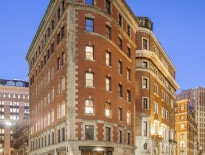The real estate market in Greater Boston may be on a record roll when it comes to home and condominium prices, but there’s trouble brewing on the horizon.
And as we move into 2017, until now, simply irksome issues – the flood of new luxury apartments hitting the market, rising mortgage rates and, at the other end of the market, a dearth of single-family homes for sale – are poised to take on greater significance.
In the case of the increasingly glutted luxury apartment market, we could very well start to see the bursting of a rental market bubble as developers and bankers alike start to pull back.
By contrast, rising interest rates aren’t likely to trigger an imminent crash, but they could start to slow the market down in terms of new sales and price increases.
As for the shortage of listings in the Boston area, hopefully we will hit bottom in 2017, but there’s no guarantee either of any significant relief for stressed out buyers.
Developers, or at least the most successful ones, are often extolled as bold risk takers, betting everything on a big new project that strikes gold.
And to be sure, there are a few builders out there that fit that old stereotype. In Boston, the late, great Norman Leventhal, who gave us that urban gem, the Post Office Square Park, and John Hynes, the maestro behind the multibillion-dollar Seaport Square development.
Yet more than a few developers are cautious, follow-the-pack trend followers, rather than trendsetters, looking for the next wave to ride and leaping only after others have gone first. (The problem with pioneers, one major developer on Boston’s waterfront once told me, is that they wind up full of arrows.) And in more than a few cases, this has led to a whole bunch of copycat projects hurtling over the proverbial cliff like so many lemmings.
The classic example is the telecom hotel boom of the late 1990s, which saw a gold rush like scramble to snap up old warehouses and convert them into data hubs ready to service the then-budding and internet revolution.
But the bursting of the dot.com bubble left more than a few developers sitting with lots of empty rooms at the good old telecom inn. A prime example of the folly of trend chasing can be seen in the hulking empty glass and steel building that overlooks the Pike in Brighton, a former telecom hotel once dubbed “Boston Internet City” and now surplus property owned by Harvard.
So here we go again, except instead of telecom hotels, we have luxury apartment towers.
Really, how many of these, overpriced, cookie-cutter high-rises and boxes do we need? Banks were skittish about lending on new condo projects coming out of the recession but, for a few years anyway, were more than happy to finance less risky apartment projects. Developers rushed in with the belief that just about every street corner needs hundreds of new $3,000 and $4,000 a month apartments.
Warning Signs
Now, five years and thousands of new apartments later, the luxury rental boom is poised to go bust. Worrisome signs are coming out of previously red hot markets like Miami and New York, where there has been epic overbuilding of both deluxe apartments and condos.
Sales of co-op apartments in New York worth $4 million and up recently plunged 25 percent amid fierce competition from new units, while Miami has its own growing luxury apartment and condo glut.
Meanwhile, construction starts on new apartment projects have also started to drop in the Boston area, another sign that developers may be starting to get cold feet. Bankers have been growing wary as well for more than a year now.
Add to that all sorts of freebies being used by developers to fill up these empty towers, from “free rent” to gift cards, and you get the picture.
Yes, we desperately need more housing, especially the kind middle and working class families can afford, not more outrageously priced apartments.
It’s already tough to buy a home in the Boston area, especially if you are living on a middle class budget.
But over the past month, it has gotten noticeably harder, with a spike in mortgage rates upping the amount homebuyers can expect to pay each month.
Mortgage rates are now hovering around the 4.2 mark, up more than half a point since their low of 3.54 in September. That means well more than $100 extra each month in mortgage payments – or about an 8 percent increase – on a $400,000 home.
By early 2018, we could be looking at mortgage rates topping 5 percent, according to the Mortgage Bankers Association.
Homebuyers are already starting to adjust, looking at slightly less expensive homes, brokers here and around the country say.
That, in turn, could help slow down increases over the next year and maybe even motivate some sellers to cut their asking prices.
But that’s not likely to happen overnight. In the meantime, buyers in Greater Boston and beyond are likely to be stuck with the worst of both worlds, a combination of reducing purchasing power and still sky-high prices.
Inventory Crunch
It wouldn’t seem as if the dire shortage of homes for sale in the Boston area could get much worse.
After all, the number of homes for sale plunged 34 percent in November, the Massachusetts Association of Realtors reports. At 14,300, the number of homes on the market was the lowest since MAR began tracing inventory in 2004.
So is there any reason to hope that 2017 might mark the low point in this years-long trend? Maybe, but nothing I would bet the bank on.
Certainly rising interest rates could force some buyers to bypass more the more expensive homes out there, resulting in some higher end listings staying on the market longer. (In fact, we are already starting to see that in the western suburbs). Maybe that might result in an uptick in inventory, but probably not one particularly useful for first-time buyers battling it out for scarce starter homes.
That said, we are likely to see a modest increase in the number of new single-family homes built in Massachusetts in 2016 when the final numbers are tallied.
And state lawmakers are increasingly turning their attention to our restrictive local zoning rules that have long been the major reason why there are simply too few homes for sale.
Here’s a toast to 2017: May rates not rise too fast and may stressed-out homebuyers here and everywhere catch a break. And may developers finally kick the luxury apartment habit before it’s too late and move onto something new and novel, like middle class housing.




 |
| 




